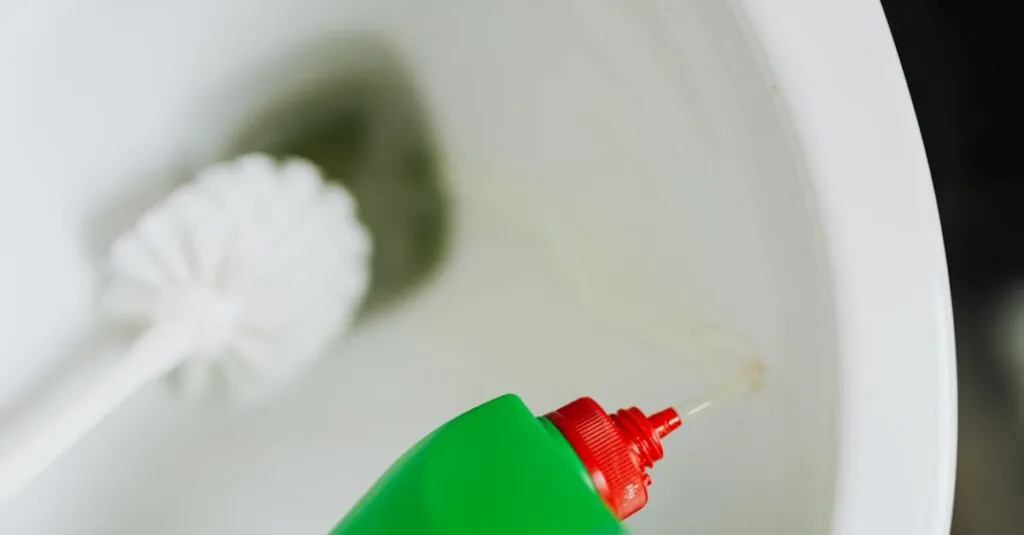In a world where the quest for sustainability feels like a race against time, green sanitation solutions are stepping up to the plate—like superheroes in eco-friendly capes. These innovative approaches not only tackle the age-old problem of waste management but do so while saving the planet one compost bin at a time. Who knew that going green could be this much fun?
Table of Contents
ToggleOverview of Green Sanitation Solutions
Green sanitation solutions incorporate practices that enhance waste management while protecting the environment. They address issues related to sanitation by utilizing sustainable methods and materials. Various technologies exist within this realm, including composting toilets, biogas digesters, and waterless urinals. These systems reduce water consumption and mitigate pollution.
Composting toilets convert human waste into compost using aerobic decomposition. As a result, they provide an eco-friendly alternative to traditional flush toilets. Biogas digesters transform organic waste into renewable energy. This process not only produces methane for cooking but also generates nutrient-rich fertilizer. Waterless urinals, designed for minimal water use, effectively reduce the strain on existing sewage systems.
In addition to these technologies, green sanitation practices emphasize community involvement and education. Promoting awareness about the benefits of these solutions helps shift perceptions regarding waste. Communities that adopt green sanitation methods often experience improved public health outcomes. Enhanced sanitation infrastructure contributes to cleaner environments, which fosters overall well-being.
Municipalities are increasingly prioritizing green sanitation solutions to achieve sustainability goals. Integrating eco-friendly practices into waste management strategies demonstrates commitment to environmental stewardship. Many cities are already implementing policies that focus on reducing waste generation through green alternatives. Innovative approaches can yield long-term savings while preserving natural resources.
These solutions not only address sanitation but also offer potential economic advantages. Investing in green technologies can create job opportunities in installation, maintenance, and education. The positive impact on both the environment and local economies illustrates the multifunctional benefits of embracing green sanitation solutions.
Benefits of Green Sanitation Solutions
Green sanitation solutions offer numerous advantages that positively influence both people and the planet. These eco-friendly approaches significantly lower environmental degradation and enhance public health.
Environmental Impact
Green sanitation solutions play a vital role in reducing pollution and conserving water. Composting toilets transform human waste into nutrient-rich compost, minimizing the volume of waste disposed of in landfills. Biogas digesters generate renewable energy while producing organic fertilizers, contributing to soil health. Waterless urinals cut down on water consumption, lessening strain on local water resources. Municipalities adopting these technologies experience lower greenhouse gas emissions, which aligns with global sustainability goals. With these systems in place, communities can experience cleaner water sources and reduced risks of environmental contamination.
Health Benefits
Implementing green sanitation practices leads to significant health improvements. Enhanced waste management prevents the spread of diseases linked to untreated waste. Communities utilizing composting toilets report fewer instances of illness from waterborne pathogens. Access to clean and safe sanitation reduces exposure to harmful chemicals often found in traditional waste management systems. Healthier environments result in higher quality of life and overall well-being for residents. Investing in green sanitation solutions showcases a commitment to public health and environmental stewardship, which benefits society as a whole.
Types of Green Sanitation Solutions
Green sanitation solutions encompass a variety of innovative technologies that promote sustainability while effectively managing waste. Below are three primary types of green sanitation solutions recognized for their environmental benefits.
Composting Toilets
Composting toilets transform human waste into compost, reducing landfill contributions. These systems operate without water, conserving this vital resource. They utilize aerobic decomposition, which minimizes odors and pathogens. By turning waste into nutrient-rich compost, users can contribute to soil health. This method encourages sustainable agricultural practices by providing organic fertilizers.
Biogas Systems
Biogas systems convert organic waste into renewable energy. These systems use anaerobic digestion to break down waste, producing biogas as a byproduct. This gas can power homes or provide energy for cooking. Additionally, biogas digesters yield organic fertilizers, enhancing soil quality. By implementing such systems, communities can decrease reliance on fossil fuels and lower greenhouse gas emissions.
Eco-Friendly Cleaning Products
Eco-friendly cleaning products ensure sanitation without harming the environment. These products rely on natural ingredients, which reduce chemical runoff in water systems. They effectively remove dirt and pathogens while being biodegradable. Choosing these alternatives improves indoor air quality and user health. Adoption of eco-friendly cleaning products highlights a commitment to sustainability and public health.
Challenges in Implementing Green Sanitation Solutions
Implementing green sanitation solutions presents several challenges that must be addressed for successful integration.
Cost Considerations
Cost plays a significant role in adopting green sanitation technologies. Initial investments often include purchasing equipment and installing systems such as composting toilets or biogas digesters. Many municipalities face budget constraints that limit their ability to allocate funds towards these eco-friendly technologies. Long-term savings from reduced water usage and lower waste management costs can offset these initial expenses. However, securing grants or subsidies for green projects remains essential for many communities. Balancing upfront costs with future savings makes financial planning crucial for stakeholders.
Public Perception
Public perception significantly affects the adoption of green sanitation solutions. Many individuals hold misconceptions about composting toilets and biogas systems, often associating them with poor hygiene or inefficiency. Overcoming these stereotypes requires targeted education campaigns to inform communities about the benefits of these technologies. Positive testimonials from users can help alleviate concerns and build trust in innovative systems. Community engagement fosters acceptance, making implementation smoother. Ultimately, when people understand the advantages, their support enhances the success of green sanitation initiatives.
Conclusion
Embracing green sanitation solutions is essential for a sustainable future. These innovative systems not only address waste management challenges but also promote environmental health and public well-being. By reducing water consumption and minimizing pollution, they pave the way for cleaner communities and healthier ecosystems.
Community involvement and education play crucial roles in overcoming barriers to adoption. As municipalities integrate these eco-friendly practices into their waste management strategies, they demonstrate a commitment to environmental stewardship and public health. The economic advantages further highlight the potential of green sanitation solutions to create jobs and foster sustainable growth.
Investing in these technologies is not just a choice; it’s a responsibility towards the planet and future generations. The journey towards a greener world begins with informed decisions and collective action.




